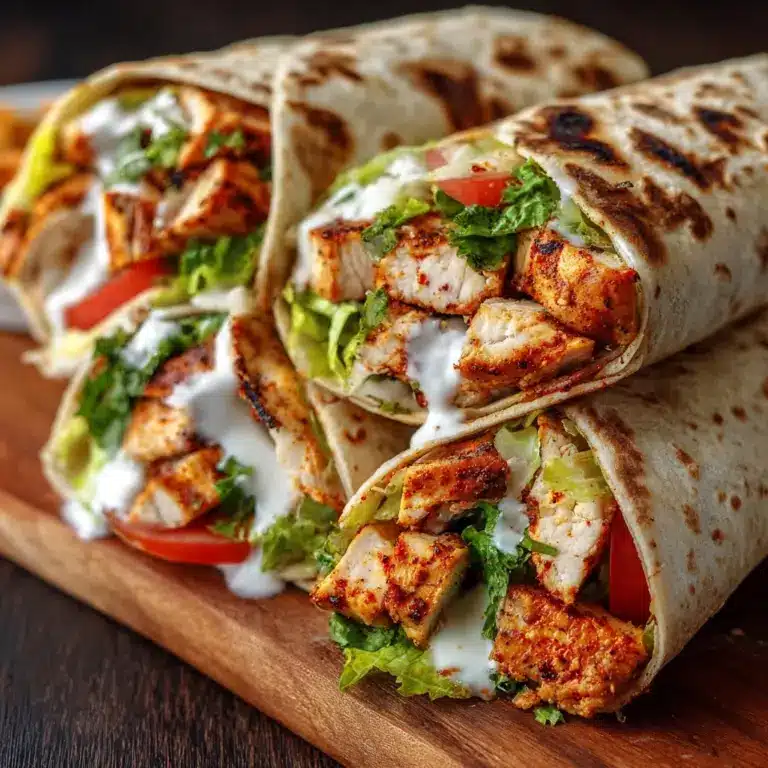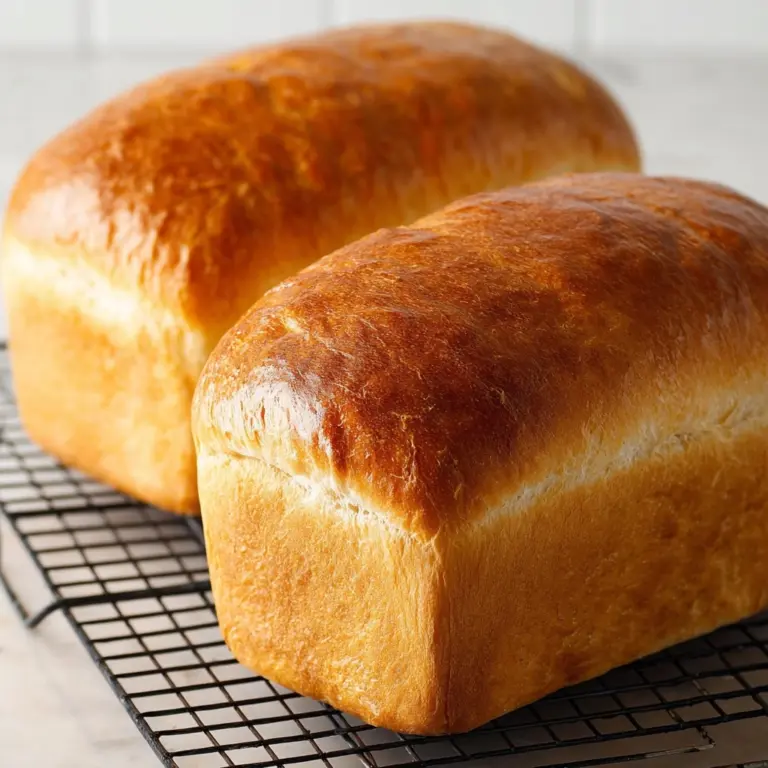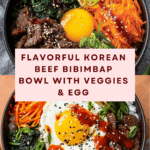Korean Beef Bibimbap Bowl Recipe
If you are looking to dive into a vibrant, flavorful meal that’s comforting and visually stunning, the Korean Beef Bibimbap Bowl is an absolute must-try. This dish brings together perfectly seasoned ground beef, fresh sautéed vegetables, fluffy rice, and a runny egg on top all brightened with a kick of spicy gochujang sauce. Every bite delivers a delightful mix of textures and tastes, making it a personal favorite that feels both wholesome and indulgent. The Korean Beef Bibimbap Bowl is not just food; it’s an experience that embodies warmth and soul in each colorful, delicious layer.
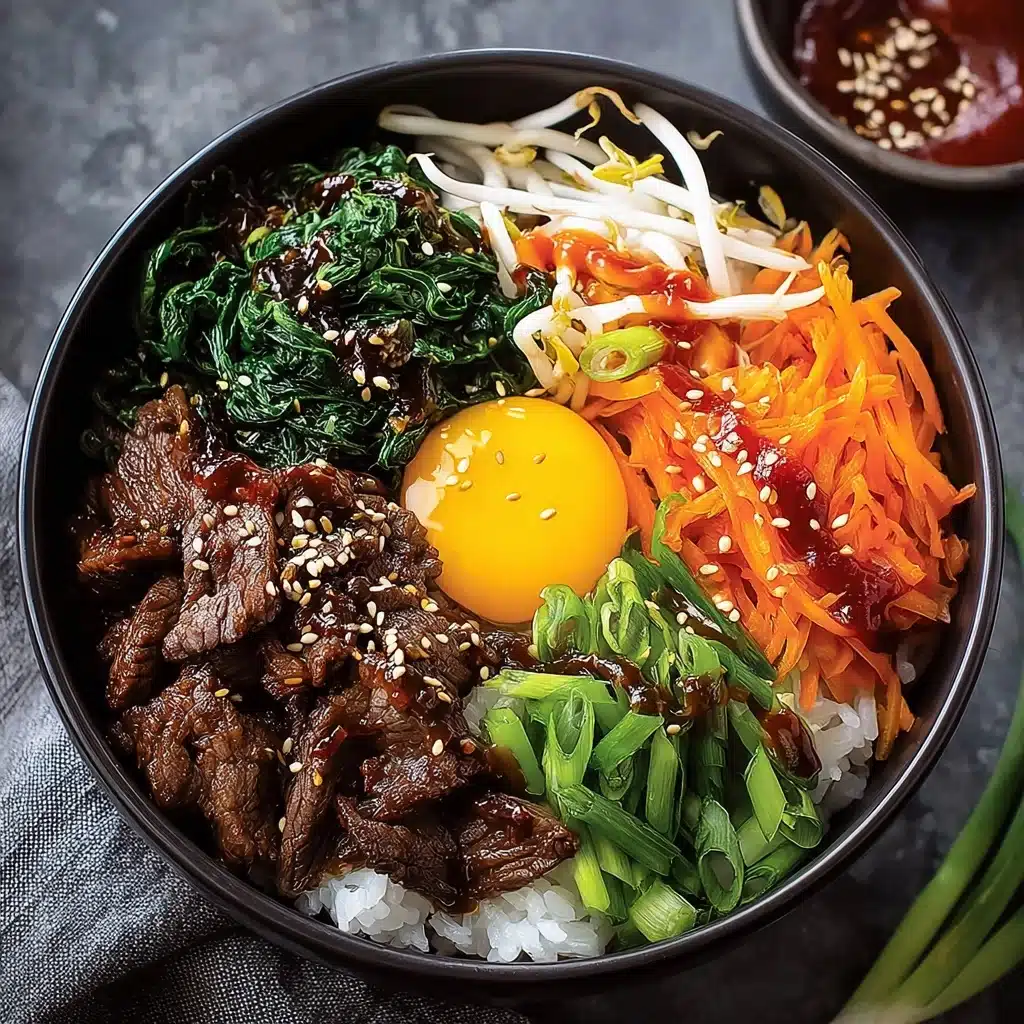
Ingredients You’ll Need
Gathering simple yet essential ingredients is key to building the delightful harmony found in this dish. Each component plays a role in introducing different textures, colors, and rich flavors that elevate the overall bowl into something truly special.
- Lean ground beef: The protein backbone that soaks up all the savory seasonings beautifully, providing a meaty depth.
- Short-grain white rice: Sticky and tender, it forms the comforting bed that holds everything together perfectly.
- Carrots (julienned): Offer a subtle sweetness and crisp bite to contrast the richer elements.
- Spinach (fresh): Brings a healthy pop of green and a mild, earthy flavor when lightly sautéed.
- Zucchini (sliced): Adds tenderness and a slightly fresh, watery crunch that balances the bowl.
- Bean sprouts: These little bursts of freshness give a crunchy texture and a clean taste.
- Gochujang sauce: The heart of Korean flavor here, this chili paste gives smoky heat and a touch of sweetness.
- Sesame oil: Used for cooking and flavoring, it imparts a nutty aroma that lifts the dish beautifully.
- Low-sodium soy sauce: Enhances the umami notes without overpowering, keeping the beef savory and balanced.
- Eggs: Fried sunny-side up, they top the bowl with creaminess and richness, bringing everything together.
How to Make Korean Beef Bibimbap Bowl
Step 1: Cook the Rice
Start by cooking your short-grain white rice according to the package instructions. This rice variety is essential because its sticky texture helps hold all the elements of the bibimbap together, making every bite cohesive and satisfying. Set it aside once cooked and keep it warm.
Step 2: Brown the Ground Beef
Heat a skillet over medium-high and brown the lean ground beef until it is fully cooked and slightly caramelized, about 5 to 7 minutes. Be sure to drain any excess fat so the dish doesn’t turn greasy. This caramelization step adds wonderful depth to the meat, giving you those rich savory notes throughout the bowl.
Step 3: Add Flavor to the Beef
Once browned, stir in the gochujang sauce, soy sauce, and sesame oil. Reduce the heat to low and let it simmer for 5 minutes. This slow simmer allows those spicy, salty, and nutty flavors to fully infuse into the beef, making it bold yet balanced— a hallmark of any great Korean Beef Bibimbap Bowl.
Step 4: Sauté the Vegetables
While the beef simmers, sauté the carrots, spinach, zucchini, and bean sprouts in a little sesame oil over medium heat. Cook until the vegetables are tender but still hold some crispness, about 7 minutes. These fresh veggies build a rainbow of texture and color, creating visual appeal and perfectly refreshing each bite.
Step 5: Fry the Eggs
In a separate pan, fry your eggs sunny-side up. The goal is to have whites that are set with yolks that are still liquid and rich, as that golden yolk will mingle beautifully with the other ingredients once the bowl is assembled. It’s pure magic to break into that runny yolk at the end.
Step 6: Assemble Your Korean Beef Bibimbap Bowl
To build the bowl, start with a generous scoop of warm rice as your base. Layer on the spicy beef mixture, then arrange the sautéed vegetables neatly around the bowl. Finally, crown your creation with the sunny-side-up egg. If you like, add a drizzle of extra gochujang on top for another kick of flavor.
How to Serve Korean Beef Bibimbap Bowl
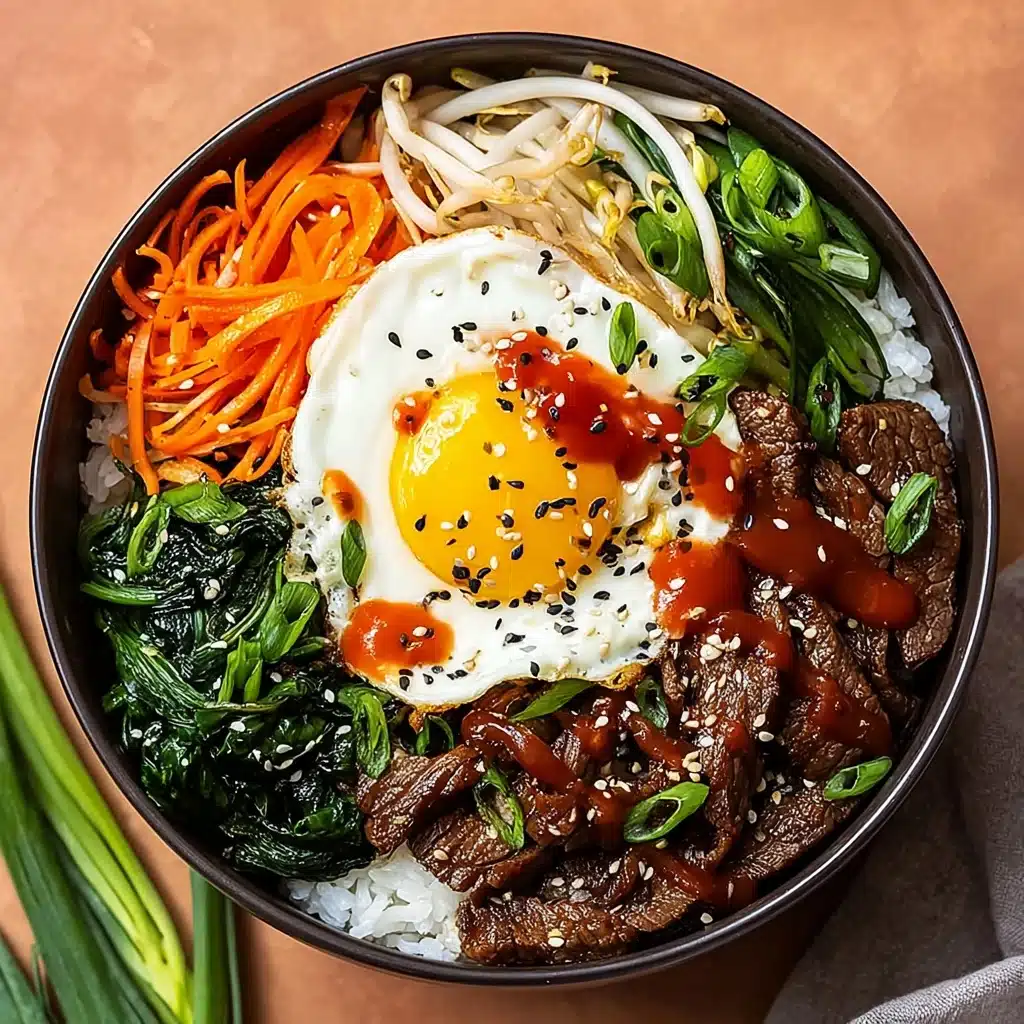
Garnishes
Adding garnishes such as toasted sesame seeds and thinly sliced green onions will enhance both the flavor and presentation of your Korean Beef Bibimbap Bowl. These little touches add an extra crunch and vibrant freshness that make serving this dish feel special and festive every time.
Side Dishes
This bowl pairs beautifully with classic Korean side dishes like kimchi, pickled radishes, or even a simple seaweed salad. These sides introduce complementary flavors like tanginess and umami, creating a balanced meal that highlights the richness of the main bowl.
Creative Ways to Present
Try serving your bibimbap in a heated stone bowl, known as dolsot, if you have one—it crisps up the rice on the edges for an addictive texture contrast. Alternatively, use clear glass bowls to showcase the gorgeous layers of colorful ingredients. No matter your presentation, the Korean Beef Bibimbap Bowl always blushes with irresistible appeal.
Make Ahead and Storage
Storing Leftovers
You can store leftover Korean Beef Bibimbap Bowl components separately or assembled in airtight containers in the refrigerator for up to 3 days. Keeping the beef, vegetables, and rice apart helps maintain their individual textures better.
Freezing
While the cooked beef and vegetables freeze well individually, rice’s texture may degrade in the freezer. For best results, freeze the beef mixture in small portions, then thaw overnight in the fridge before reheating. Avoid freezing the fried egg; cook fresh when ready to serve.
Reheating
When reheating, warm the rice and beef gently in a skillet or microwave, adding a splash of water or oil to keep moisture. Reheat vegetables quickly in a pan to avoid sogginess. Fry a fresh sunny-side up egg to top it all off and revive that creamy richness.
FAQs
Can I use a different type of meat in the Korean Beef Bibimbap Bowl?
Absolutely! While ground beef is traditional and flavorful, ground turkey or chicken can be great alternatives if you want a leaner option. Just adjust cooking times to ensure the meat is cooked through and seasoned well.
Is it possible to make this dish vegetarian or vegan?
Yes, you can swap the beef for marinated tofu or tempeh and omit the egg or use a vegan egg substitute. Make sure to use a vegan-friendly gochujang sauce, and your Korean Beef Bibimbap Bowl will still be bursting with flavor.
How spicy is the gochujang sauce?
Gochujang has a moderate heat level with a balanced sweetness and savory depth. You can easily control the spice by adjusting the amount added—use less for mild heat or more if you love a kick.
What kind of rice is best for bibimbap?
Short-grain white rice is ideal because of its sticky texture which helps bind the bowl’s components well. Sushi rice or any other sticky, short-grain rice will work perfectly.
Can I prepare any parts of this dish in advance?
Yes, you can cook the rice, beef mixture, and vegetables ahead of time and refrigerate them separately. When ready to eat, simply warm everything up and fry a fresh egg to complete the bowl instantly.
Final Thoughts
I can’t stress enough how much joy this Korean Beef Bibimbap Bowl has brought to my dinner table. It’s colorful, packed with layers of tempting flavors, and surprisingly easy to put together. Whether you’re cooking for yourself or a crowd, this bowl is sure to impress and satisfy. Give it a go—I promise it’ll become one of your new favorite meals!
Print
Korean Beef Bibimbap Bowl Recipe
- Total Time: 40 minutes
- Yield: 4 servings 1x
- Diet: Low Fat
Description
A delicious and colorful Korean Beef Bibimbap Bowl featuring seasoned ground beef, sautéed vegetables, and a perfectly fried egg over steamed white rice, all topped with spicy gochujang sauce for a balanced and flavorful meal.
Ingredients
Protein
- 1 lb lean ground beef
- 4 eggs
Vegetables
- 1 cup carrots, julienned
- 1 cup fresh spinach
- 1 cup zucchini, sliced
- 1 cup bean sprouts
Grains
- 2 cups short-grain white rice (cooked)
Sauces & Oils
- 3 tbsp gochujang sauce (adjust for spice level)
- 1 tbsp sesame oil
- 2 tbsp low-sodium soy sauce
Instructions
- Cook the rice: Prepare 2 cups of short-grain white rice according to the package instructions, then set it aside to keep warm.
- Brown the ground beef: In a skillet over medium-high heat, cook 1 lb of lean ground beef for 5-7 minutes until browned, draining any excess fat to keep it lean.
- Season the beef: Stir in 3 tablespoons of gochujang sauce, 2 tablespoons of low-sodium soy sauce, and 1 tablespoon of sesame oil into the ground beef. Reduce heat to low and simmer for 5 minutes, allowing the flavors to meld.
- Sauté the vegetables: Heat a bit of sesame oil in a skillet over medium heat. Add the julienned carrots, fresh spinach, sliced zucchini, and bean sprouts. Cook until the vegetables are tender-crisp, about 7 minutes, stirring occasionally.
- Fry the eggs: In a non-stick pan, fry 4 eggs sunny-side up until the whites are set but the yolks remain runny, approximately 3 minutes each.
- Assemble the bibimbap bowls: Divide the cooked rice into bowls as the base. Top each with the seasoned ground beef mixture, the sautéed vegetables, and finish with a fried egg. Optionally, drizzle additional gochujang sauce on top to taste for extra spice.
Notes
- Adjust the amount of gochujang sauce to control the spice level.
- For a vegetarian version, substitute ground beef with marinated tofu or mushrooms.
- Use brown rice for a higher fiber and lower glycemic index option.
- To avoid runny yolks, fry eggs to your preferred doneness.
- Ensure vegetables remain crisp-tender by avoiding overcooking.
- Prep Time: 15 minutes
- Cook Time: 25 minutes
- Category: Main Course
- Method: Sautéing, Frying, Simmering
- Cuisine: Korean
Nutrition
- Serving Size: 1 bowl (approximately 1/4 of recipe)
- Calories: 520
- Sugar: 5g
- Sodium: 450mg
- Fat: 20g
- Saturated Fat: 6g
- Unsaturated Fat: 13g
- Trans Fat: 0g
- Carbohydrates: 55g
- Fiber: 4g
- Protein: 29g
- Cholesterol: 210mg
Keywords: Korean beef bibimbap, bibimbap recipe, Korean rice bowl, ground beef bibimbap, gochujang bibimbap



